Greetings, fruit lovers! Are you ready to tantalize your taste buds with a burst of sweetness and juiciness? Look no further than the fresh white nectarine. This delectable fruit is known for its irresistible combination of sweetness and a subtle hint of tartness, making it a true delight for your palate.
When you sink your teeth into a ripe white nectarine, you’ll be greeted by a juicy explosion of flavor. These gems are at their prime when they yield slightly to a gentle touch. So if you’re craving a refreshing and luscious treat, reach for a fresh white nectarine.
Not only are white nectarines perfect for snacking, but they also shine in various culinary creations. Whether you use them in cooking, baking, or as an accompaniment to cheeses and cured meats, their unique taste will elevate every dish.
So, why wait? Grab a fresh white nectarine today and indulge in its juicy delight. Your taste buds will thank you!
Key Takeaways:
- White nectarines offer a unique blend of sweetness and slight tartness.
- They are ripe and juicy when they give slightly when pressed.
- Blanching nectarines in boiling water makes them easier to peel.
- They can be used in cooking, baking, or enjoyed fresh.
- Pair them with cheeses or cured meats for a delightful combination of flavors.
Do nectarines need to be cooked?
Nectarines can be enjoyed in their natural, fresh state or cooked to bring out their delicious flavors in various recipes. Whether you prefer the juicy sweetness of a raw nectarine or the enhanced taste and texture when cooked, they offer a versatile ingredient for a range of culinary creations.
When cooked, nectarines provide a slightly more robust flavor compared to peaches, adding depth to both savory and sweet dishes. Grilling nectarines can bring out their natural sweetness and create a caramelized, smoky flavor profile. They can be used in salsas, tarts, pies, and even as a topping for grilled meats or salads.
If you are looking for creative ways to use nectarines in your cooking, there are numerous recipes available that showcase the versatility of this fruit. From roasted nectarine bruschetta to nectarine salsa with grilled shrimp, the possibilities are endless. Whether you prefer to bake, grill, or simmer nectarines, they are sure to add a burst of flavor to any dish.
So, while nectarines can be enjoyed fresh and raw, don’t hesitate to explore the many delicious recipes that highlight the unique taste and versatility of cooked nectarines. Let your culinary creativity take flight and savor the delightful flavors that this fruit can bring to your table.
“Cooking nectarines can enhance their flavors, creating a more robust taste that adds depth to both savory and sweet dishes.”
Do nectarines need to be cooked?
How do you know when a nectarine is ripe?
When it comes to enjoying the perfect nectarine, determining its ripeness is key. Thankfully, there is a simple trick to help you know when a nectarine is ready to be savored.
To determine if a nectarine is ripe, gently press into the fruit. If it gives slightly when pressed, it is ripe and ready to eat. This gentle squeeze will help you gauge the firmness of the fruit and ensure it is at its peak of sweetness and juiciness. Remember, the nectarine should not be hard or overly firm, as this indicates it is still unripe.
It’s important to note that using unripe nectarines in your cooking may result in a lack of flavor or a hard texture. So, make sure to choose ripe nectarines for your culinary adventures to truly enjoy their delicious taste and texture.
Table: Nectarine Ripeness Guide
| Squeeze Test | Ripeness Level |
|---|---|
| Gives slightly when pressed | Ripe and ready to eat |
| Firm and doesn’t give when pressed | Unripe |
Now that you know how to determine when a nectarine is ripe, you can confidently choose the perfect fruit for your enjoyment. Whether you decide to savor the nectarine on its own or incorporate it into mouthwatering recipes, you can savor the unique blend of sweet and slightly tart flavor that makes nectarines so irresistible.
So, next time you’re at the grocery store or farmer’s market, remember to use the gentle squeeze test to ensure you bring home the most delicious nectarines for your culinary escapades.
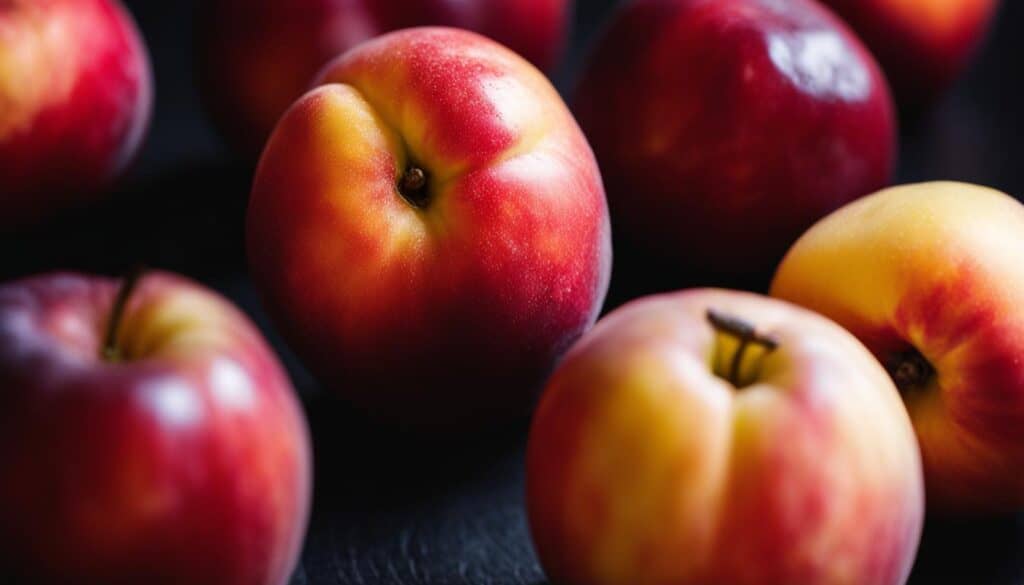
How do I peel a nectarine?
To peel a nectarine, you can use a simple blanching technique. Follow these easy steps:
- Bring a pot of water to a boil.
- Using a sharp knife, make a small X-shaped incision on the bottom of the nectarine.
- Drop the nectarine into the boiling water and let it blanch for about 30 seconds.
- Using a slotted spoon, transfer the nectarine to a bowl of ice water to cool.
- Once the nectarine is cool, use your fingers or a knife to gently peel off the skin. It should come off easily.
And that’s it! You now have a perfectly peeled nectarine ready to be enjoyed.
“Blanching nectarines in boiling water makes it easier to peel them. They can be used in cooking and baking, similar to peaches. They are also delicious when eaten fresh or paired with cheeses or cured meats.” – Me
Peeling nectarines not only makes them easier to eat, but it also allows you to use them in a variety of recipes. You can add peeled nectarines to fruit salads, pies, tarts, and even smoothies. Their sweet and tangy flavor adds a burst of freshness to any dish.
So the next time you have some juicy nectarines on hand, don’t hesitate to give them a quick blanch and enjoy them peeled and ready to go!
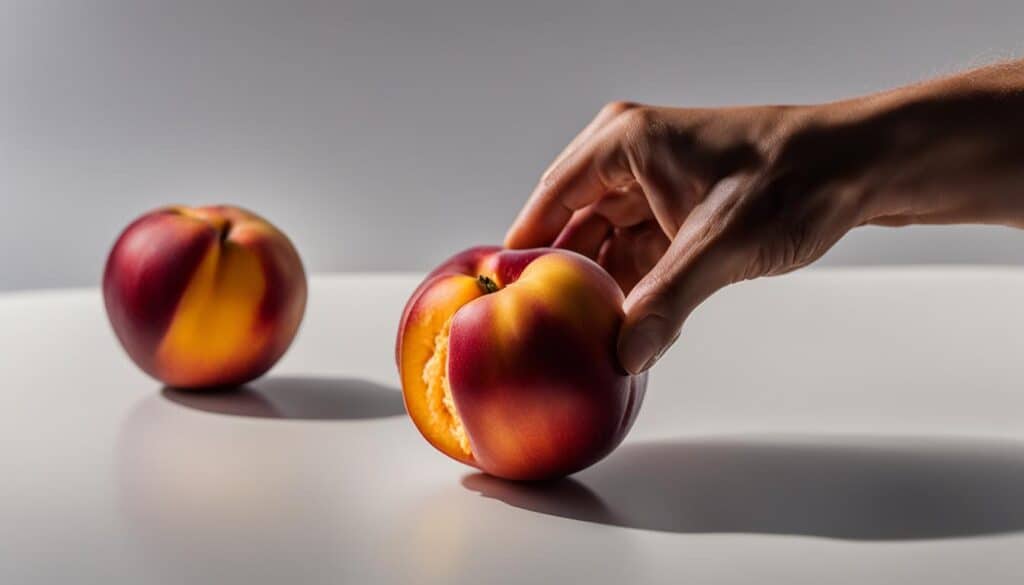
Can I use nectarines in apple pies?
Yes, you can absolutely use nectarines in apple pies, either as a substitute for part of the apples or even as a complete replacement. Nectarines add a unique twist to traditional apple pies, with their slightly different flavor profile and juicy texture. The combination of sweet and tangy flavors from the nectarines, along with the warm spices and buttery crust, creates a delicious and refreshing dessert.
When using nectarines in apple pies, it’s important to consider their moisture content. Nectarines tend to be juicier than apples, so you may need to adjust the amount of thickener, such as cornstarch or flour, to ensure the filling is not too runny. Additionally, nectarines have a softer texture compared to apples, so they may break down more quickly during baking. To prevent this, you can try using slightly firmer nectarines or slightly reduce the baking time.
To enhance the flavor of the nectarines in the pie, you can also add complementary ingredients such as cinnamon, nutmeg, or vanilla extract. These spices will help accentuate the natural sweetness and aromatic qualities of the nectarines, creating a harmonious blend of flavors in every bite.
| Recipe: | Ingredients: | Instructions: |
|---|---|---|
| Apple-Nectarine Pie |
|
|
So next time you’re craving a delicious and unique twist on the classic apple pie, consider using nectarines in your recipe. With their juicy texture and slightly different flavor, nectarines will elevate your pie to a whole new level of fruity goodness.

References:
“Apple and Nectarine Pie Recipe.” Taste of Home. Accessed [insert month day, year]. https://www.tasteofhome.com/recipes/apple-and-nectarine-pie/
Are nectarines supposed to be soft or hard?
If you’ve ever wondered about the texture of nectarines, you’re not alone. Nectarines are supposed to be slightly soft when gently pressed, indicating that they are ripe and ready to eat. Unlike hard nectarines, which may lack flavor and have a firm texture, ripe nectarines offer a juicy and satisfying bite. So, if you’re unsure about the ripeness of a nectarine, remember that a little softness is a good sign.
When selecting nectarines, it’s important to find ones that are at their peak ripeness. If the nectarines feel hard or unyielding to the touch, they are likely not yet ripe. On the other hand, if they feel overly soft or mushy, they may be overripe and past their prime. The optimal texture is a slight give when gently pressed, indicating that the fruit is ripe and ready to enjoy.
So, the next time you’re at the grocery store or farmer’s market and wondering about the texture of nectarines, remember that ripe nectarines should be slightly soft. This is the perfect indication that they are ready to be eaten and relished. Enjoy the juicy delight of a ripe nectarine today!
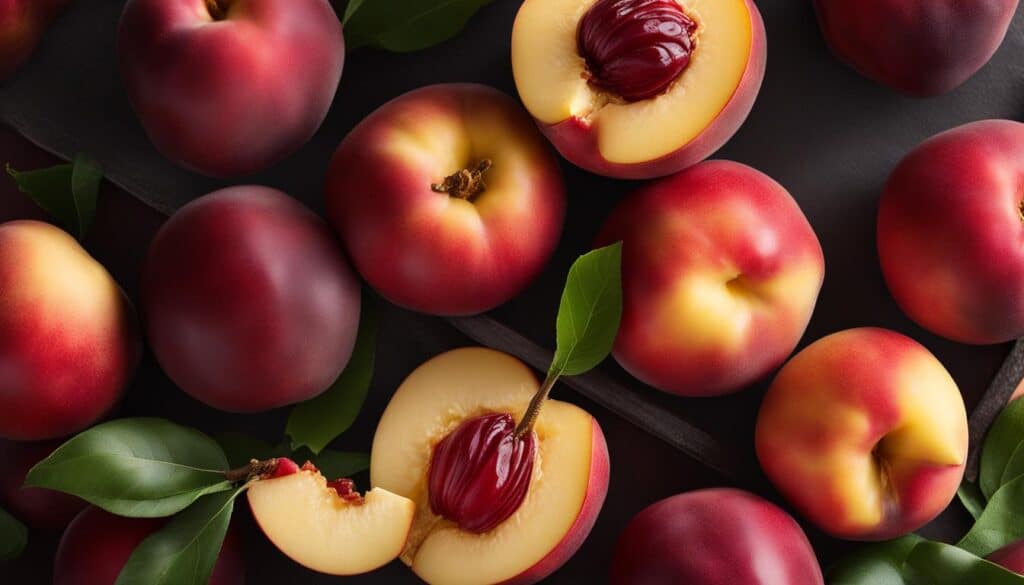
Table: How to determine the ripeness of a nectarine:
| Texture | Ripeness |
|---|---|
| Slightly soft | Ripe and ready to eat |
| Hard and firm | Not yet ripe |
| Very soft and mushy | Overripe |
As shown in the table above, the texture of a nectarine is a key indicator of its ripeness. When it comes to selecting the perfect nectarine, opt for those that are slightly soft, providing a burst of juiciness and flavor with every bite. So, whether you’re enjoying a nectarine on its own or incorporating it into your favorite recipes, be sure to savor its tempting texture and delightful taste.
Should I refrigerate nectarines?
When it comes to storing nectarines, refrigeration can be a useful option to extend their shelf life. However, it’s important to note that refrigeration may slightly affect the texture and flavor of the fruit. Let’s take a closer look at the best practices for storing nectarines.
Before refrigerating nectarines, it’s essential to allow them to fully ripen at room temperature. Once they are ripe and ready to eat, you can transfer them to the refrigerator to slow down the ripening process. This can help prevent over-ripening and spoilage, allowing you to enjoy your nectarines for a longer period.
However, bear in mind that refrigerated nectarines may become slightly softer and lose a bit of their fresh, crisp texture. The flavor may also be slightly affected, although the overall taste should remain delicious. If you prefer nectarines with a firmer texture, it’s recommended to consume them at room temperature rather than refrigerating them.
| Storing nectarines | Room temperature | Refrigerated |
|---|---|---|
| Best for | Firmer texture | Extended shelf life |
| Texture | Crisp and firm | Slightly softer |
| Flavor | Intense and fresh | Slightly affected |
In conclusion, refrigeration is a viable option for storing nectarines and prolonging their shelf life. However, take into consideration the slight changes in texture and flavor that may occur. Ultimately, the decision to refrigerate nectarines depends on your personal preference for texture and the desired freshness of the fruit.

Do Nectarines and Peaches Taste the Same?
When it comes to the taste of nectarines versus peaches, there are some subtle differences that set them apart. While both fruits belong to the same family and share similarities, nectarines have a slightly different flavor profile. Nectarines are known for their unique blend of sweet and slightly tart taste, which adds a delightful twist to various dishes.
Unlike peaches, nectarines have a smoother skin and a firmer texture. This makes them perfect for enjoying fresh, as they are juicy and bursting with flavor. Their slightly tart edge adds a refreshing element that can be a pleasant surprise for those who are used to the sweetness of peaches.
Whether enjoyed on their own or incorporated into recipes, nectarines offer a distinct taste experience. Their combination of sweetness and tanginess makes them a versatile fruit that can be used in both savory and sweet dishes. From salads to desserts, nectarines can elevate the flavors and add a unique touch to any culinary creation.
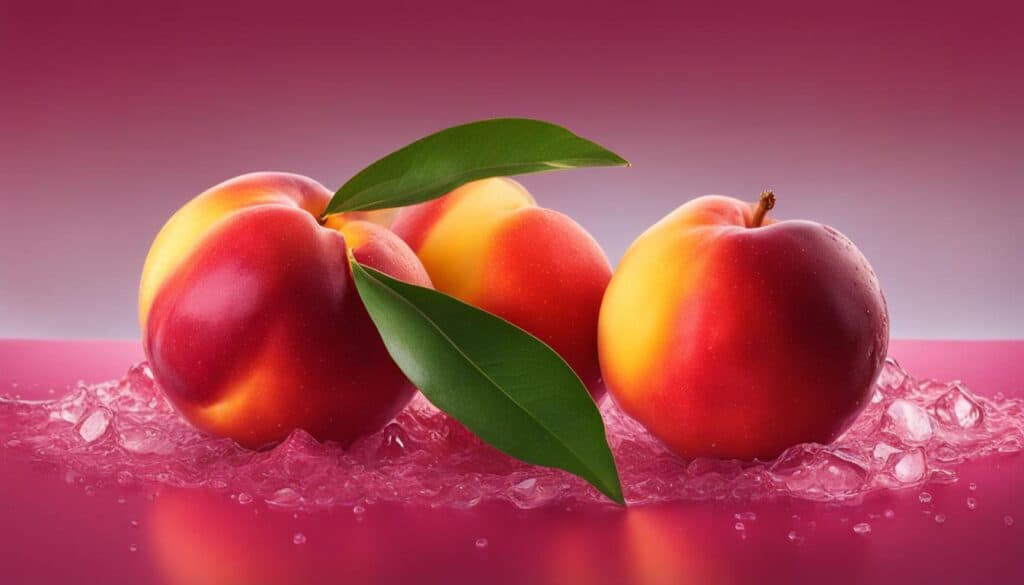
So, while nectarines and peaches may share some similarities, they have their own distinct flavors that set them apart. If you’re looking to add a bit of tangy sweetness to your meals, nectarines are a delicious choice that can bring a fresh and unique element to your culinary adventures.
How do I use nectarines in a salad?
Nectarines are a versatile fruit that can add a burst of fresh and juicy flavor to salads. They pair well with a variety of ingredients, creating a delightful mix of textures and tastes. Here are a few delicious salad recipes that incorporate nectarines:
1. Nectarine and Arugula Salad
This refreshing salad combines the crispness of arugula with the sweetness of nectarines. Toss together arugula, sliced nectarines, crumbled feta cheese, and toasted walnuts. Drizzle with a tangy balsamic vinaigrette for a perfect balance of flavors.
2. Grilled Nectarine Salad
Grilling nectarines brings out their natural sweetness and adds a smoky depth to the salad. Slice nectarines and grill them until slightly charred. Combine the grilled nectarines with mixed greens, crumbled goat cheese, toasted almonds, and a light citrus dressing for a delightful summer salad.
3. Spinach and Nectarine Salad
This vibrant salad combines baby spinach, sliced nectarines, red onion, crumbled blue cheese, and candied pecans. Toss it all together with a tangy honey mustard dressing for a delicious and satisfying salad.
Get creative with your salad combinations by adding grilled chicken or shrimp for a protein boost, or by incorporating other fruits like strawberries or blueberries for added sweetness. The possibilities are endless when it comes to using nectarines in salads, so don’t be afraid to experiment and create your own unique combinations!
| Salad | Ingredients | Dressing |
|---|---|---|
| Nectarine and Arugula Salad | Arugula, sliced nectarines, crumbled feta cheese, toasted walnuts | Balsamic vinaigrette |
| Grilled Nectarine Salad | Mixed greens, grilled nectarines, crumbled goat cheese, toasted almonds | Citrus dressing |
| Spinach and Nectarine Salad | Baby spinach, sliced nectarines, red onion, crumbled blue cheese, candied pecans | Honey mustard dressing |
So next time you want to add a touch of sweetness and juiciness to your salads, reach for some ripe nectarines. Their unique flavor and texture will elevate your salad game and leave you wanting more!
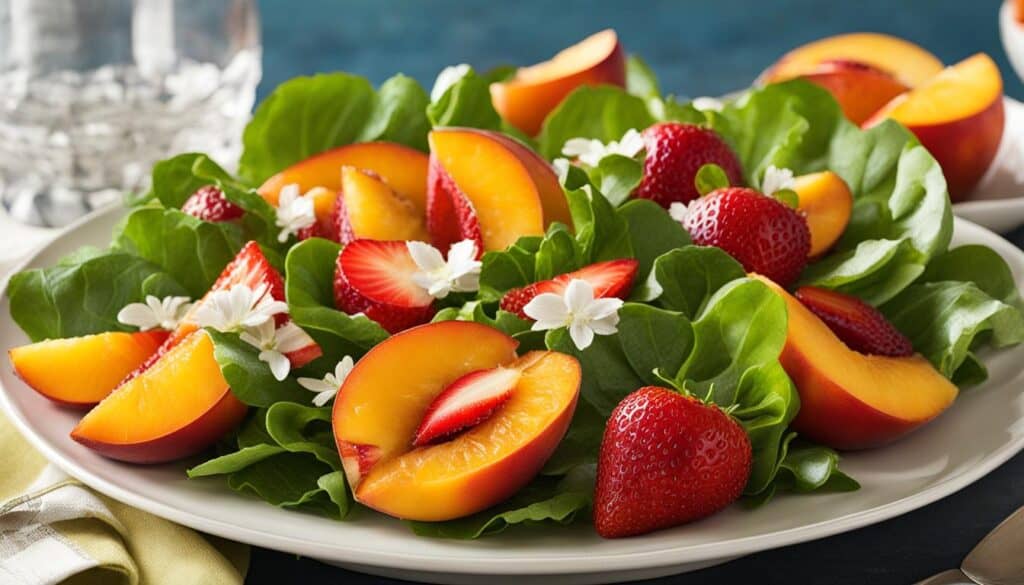
Can I substitute peaches for nectarines in a recipe?
When it comes to cooking and baking, it’s not uncommon to wonder if you can substitute one ingredient for another. If you find yourself with a recipe that calls for nectarines but only have peaches on hand, you’ll be glad to know that you can indeed substitute peaches for nectarines in many recipes. Both fruits belong to the same family and share similar flavors, so the substitution can work well in most cases.
However, it’s important to keep in mind that while peaches and nectarines are similar, they do have slight differences. Nectarines have a smooth skin while peaches have a fuzzy skin. This difference in texture may not matter much in certain recipes, but it’s worth considering if the texture of the fruit is an important aspect of the dish. Additionally, peaches may have a slightly different texture compared to nectarines, which could impact the overall mouthfeel of the dish.
To ensure a successful substitution, consider the specific recipe you’re working with. If the nectarines in the recipe are being cooked or baked, peaches should work well as a substitute. However, if the nectarines are being used for their fresh and juicy texture, the substitution may not be ideal. Ultimately, it comes down to personal preference and the specific flavors and textures you’re looking to achieve in your dish.
Remember, cooking and baking is all about experimentation and finding what works best for you. So, don’t hesitate to substitute peaches for nectarines if that’s what you have on hand. Get creative in the kitchen and enjoy the delicious flavors that both fruits have to offer!

Table: Differences Between Peaches and Nectarines
| Aspect | Peaches | Nectarines |
|---|---|---|
| Skin Texture | Fuzzy | Smooth |
| Overall Texture | Soft and Juicy | Soft and Juicy |
| Flavor | Sweet and Juicy | Sweet and Slightly Tart |
As shown in the table above, the main difference between peaches and nectarines lies in their skin texture. Peaches have a fuzzy exterior, while nectarines have a smooth skin. Both fruits offer a soft and juicy texture, making them suitable for a variety of recipes.
In terms of flavor, peaches are known for their sweet and juicy taste, while nectarines have a similar sweetness but with a slightly tart undertone. This subtle difference in flavor can bring a unique twist to your recipes depending on the flavor profile you’re aiming for.
So, whether you choose to use peaches or nectarines in your recipe, rest assured that both fruits will provide a delightful burst of flavor. Experiment with different combinations and enjoy the versatility that these fruits bring to your culinary creations.
Can I Freeze Nectarines?
Yes, nectarines can be easily frozen to preserve their freshness and flavor for later use. Freezing nectarines is a great way to extend their shelf life and ensure you have a supply of this delicious fruit all year round. Whether you have an abundance of ripe nectarines or simply want to stock up on this juicy delight, freezing is a simple and convenient method.
To freeze nectarines, start by washing and thoroughly drying the fruit. Then, slice the nectarines into desired shapes, such as wedges or cubes, or leave them whole if preferred. Place the sliced or whole nectarines in a single layer on a baking sheet lined with parchment paper. This will prevent them from sticking together during the freezing process.
Once the nectarines are frozen solid on the baking sheet, transfer them to a resealable freezer bag or an airtight container. Make sure to label the container with the date to keep track of their freshness. When you’re ready to use the frozen nectarines, simply take out the desired amount and thaw them in the refrigerator or use them directly in smoothies, baked goods, or other recipes.
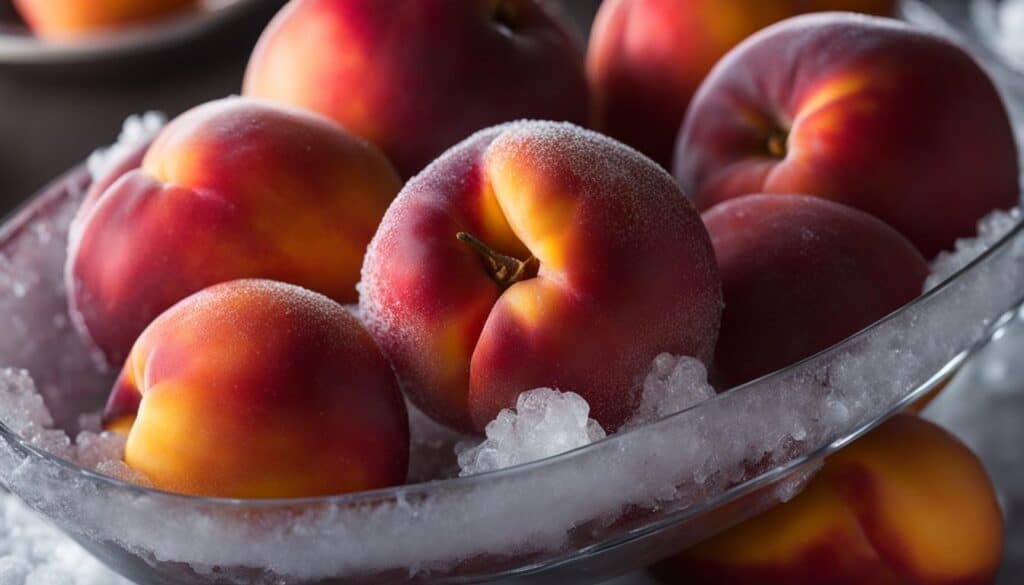
Freezing nectarines allows you to enjoy their sweet and tangy flavor even when they are out of season. They can be used in a variety of dishes, from pies and cobblers to jams and sauces. So, go ahead and freeze your nectarines to savor their deliciousness whenever you desire.
Conclusion
In conclusion, white nectarines offer a delightful combination of taste and nutritional benefits. These juicy fruits are not only delicious but also packed with essential vitamins and minerals. One of the key benefits of white nectarines is their high vitamin C content, which boosts the immune system and promotes overall health.
Additionally, white nectarines are a great source of potassium, an important mineral that helps maintain healthy blood pressure levels and supports heart health. Incorporating these fruits into your diet can contribute to a well-rounded, nutrient-rich eating plan.
Whether enjoyed fresh, used in cooking or baking, or added to salads, white nectarines bring a burst of sweetness and flavor to every dish. Their unique taste and versatility make them a wonderful addition to any meal or snack. So why not savor the goodness of fresh white nectarines and experience their juicy delight today?
FAQ
Q: Do nectarines need to be cooked?
A: Nectarines can be enjoyed fresh or cooked. They can be used in various recipes, including baking, grilling, salsas, and desserts.
Q: How do you know when a nectarine is ripe?
A: To determine if a nectarine is ripe, gently press into the fruit. If it gives slightly, it is ripe and ready to eat.
Q: How do I peel a nectarine?
A: To peel a nectarine, blanch it quickly in boiling water and then transfer it to ice water. The skin will easily peel off, revealing the juicy flesh underneath.
Q: Can I use nectarines in apple pies?
A: Yes, you can substitute nectarines for part or all of the apples in apple pies. Nectarines provide a slightly different flavor compared to apples, adding a unique twist to traditional apple pies.
Q: Are nectarines supposed to be soft or hard?
A: Ripe nectarines should be slightly soft when gently pressed. They should not be hard or overly firm.
Q: Should I refrigerate nectarines?
A: Nectarines can be stored at room temperature until they are fully ripe. Once ripe, they can be refrigerated to prolong their shelf life. However, refrigeration may affect the texture and flavor slightly.
Q: Do nectarines and peaches taste the same?
A: While nectarines and peaches belong to the same family, nectarines have a slightly different taste compared to peaches. Nectarines are known for their unique blend of sweet and slightly tart flavor.
Q: How do I use nectarines in a salad?
A: Nectarines can be sliced and added to salads for a burst of fresh, juicy flavor. They pair well with a variety of salad ingredients, including greens, nuts, cheese, and vinaigrettes.
Q: Can I substitute peaches for nectarines in a recipe?
A: Yes, you can substitute peaches for nectarines in recipes. Both fruits belong to the same family and provide a similar flavor profile. However, keep in mind that peaches may have a slightly different texture compared to nectarines.
Q: Can I freeze nectarines?
A: Yes, you can freeze nectarines for later use. They can be sliced and frozen for adding to smoothies, baking, or other recipes. Freezing nectarines can help preserve their freshness and flavor.
Q: What are the nutritional benefits of white nectarines?
A: White nectarines provide a delightful combination of taste and nutritional benefits. They are rich in vitamins and minerals, including vitamin C and potassium. Their unique flavor adds a burst of sweetness to dishes, making them a versatile and enjoyable fruit to incorporate into your diet.





Leave a Reply